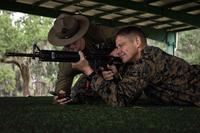Yup, from F-35B deliveries in 2011 to predictions of a 10 year budget crunch, here's a roundup of some ideas on the future of naval aviation as presented by senior Navy and Marine Corps aviation officials to an audience at the Navy League's 2011, Sea, Air, Space conference just outside of Washington DC, today.
First off, F-35 Joint Strike Fighter program manager Vice Adm. David Venlet let everyone know that it looks like the Marines will indeed receive B-model JSFs before the years end, noting that there are about 30 of the short takeoff and vertical landing planes in production under the LRIP 2 and 3 batches. While this doesn't mean the Marine's IOC date will swing back to 2012, it is a glimmer of hope for the B model which has been placed on a two year probation. So, far this year, the Bravo has demolished its flight test goals and just last week it performed its first ever automated short takeoff, according to Venlet.
Meanwhile, Lt. Gen. Terry Robling, the Marine Corps top aviation official made a rather sour prediction, saying the Pentagon should get ready for a ten year or "dual FYDP" budget crunch. This makes delivering aircraft on time and on budget all the more important lest they go away, said the three-star. This type environment adds to the importance of keeping legacy jets such as the F/A-18 Hornet in service until they are slowly replace by F-35s and the possibility that a sixth generation naval fighter may be a modified or upgraded variant of the F-35, added Robling.
Meanwhile, Coast Guard Chief of Staff, Vice Adm. John Currier said that his service needs tow new classes of maritime surveillance UAV to replace the Coasties' HC-130 Hercules transports and its fleet of helicopters that are currently being used "inappropriately" as maritime surveillance aircraft. The service needs a broad area surveillance drone (sounds like the Navy's BAMS) that can patrol wide swaths of ocean like the HC103s currently do and a smaller UAV that can serve as the eyes of the Coast Guard's cutters in the same way the service's choppers currently do, said Currier. Key to this will be following the Navy's UAV programs very closely since Coast Guard doesn't have the R&D cash needed to develop brand new UAVs for these missions.
Both Robling and NAVAIR chief, Vice Adm. David Architzel conceded that maintaining the aging fleet of F/A-18 Hornets is their number one headache when it comes to aircraft. Both noted how the Hornets were originally designed to fly about 6,000 hours before retirement and how the services have been working to push that out to 10,000 hours to help stave off a 'fighter gap' caused by the delay in fielding their replacement, the F-35. A Marine Corps F/A-18 recently suffered an engine explosion that injured 11 deck crew aboard the aircraft carrier USS John C. Stennis.
Oh, and Venlet also fired off this interesting piece of info, saying that none of the "mission system stability issues" that plagued the F-22's avionics development are present in the F-35 program. Some have worried that the JSF, with its massive amount of software code would be beset by similar problems. However, the Pentagon and F-35 partner companies have largely learned from the experience with the F-22 and have so far kept the JSF's mission system testing cruising along.
Here's one last piece of interesting information about aging naval aircraft, the Marines are apparently talking with the Brits about cannibalizing the United Kingdom's recently retired fleet of Harrier II jump jets for parts to sustain the Corps fleet of AV-8B Harriers.







